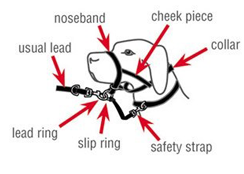
Does your dog pull you down the street, turning your daily walk into a constant struggle? Do you feel as though you must choke your dog to have control or that your arm is in danger of dislocation? Fortunately we now have tools that will change this pattern and improve your relationship with your pet.
Head collars for dogs (A.K.A halter collars) have been developed by animal behaviorists as an effective and humane way to walk your dog. There are several types of head collars available including the “Halti”, the Promise collar and the Gentle Leader. All these halters work in a similar way. The head collar for dogs works for several reasons.
Firstly, the head collar gives the handler control of the dog’s head. As the dog attempts to pull forward the head is turned towards the handler. Even large or very strong dogs are easier to control this way.
Secondly, the pressure on the bridge of the nose and behind the ears mimics the pressure exerted on a puppy by the mother. This is a natural dominance gesture and it will automatically have a calming effect on your dog. Head collars for dogs are not muzzles. Your dog will be able to open his mouth to eat, drink, and bark.
If your dog is not used to wearing a head collar, it is important to use positive reinforcement as you and your dog become accustomed to a different way of going for a walk. The following should help you get started using a head collar.
Attaching head collars for dogs:
- Tell your dog to sit and give them a reward. The SAFETY STRAP is only required during the early stages so the nose band cant be pulled off.
- Place the head collar on your dog, fastening the clasp behind the ears. The halter should fit snugly behind the ears. The strap should fit midway down the nose but you should not be able to pull the strap over the dog’s nose. Your dog should be able to open and close his mouth.
- Give your dog a special treat and give plenty of verbal praise. Remember to act happy and enthusiastic whenever the halter is put on.
- Initially, your dog will attempt to remove the head collar. He may dig at it or rub his face along the ground. Do not remove the head collar unless he has managed to get a strap in his mouth. In this case, remove the head collar and readjust it to prevent this from happening.
- Attach the lead to the ring under the halter. Use encouragement to call your dog to follow you. Give food treats and plenty of encouragement. If he stops to scratch at the head collar say “Let’s go!” or “Come on!!” and continue walking.
- Avoid pulling on the leash. At this point, do not worry about your dog heeling. The lead should be loose under your dog’s chin unless you are giving a gentle correction.
- If your dog tugs on the leash or pulls ahead, gently pull toward you. This will bring your dog’s head back toward you. As soon as your dog slows release the pressure and praise your dog.
- AVOID using the head collar in the same way as you would use a choke chain. Never jerk on the lead- this could injure your dog. Never use the halter as punishment. Your dog should always get rewards when the head collar is put on.
- When your dog is walking well, you can gradually teach him to walk closer to your side. After consistent use of the head collar your dog should be able to walk politely without a struggle.

